
DOPING STRATEGY FOR EFFICIENT AND STABLE TRIPLE CATION HYBRID PEROVSKITE SOLAR CELLS AND MODULE BASED ON POLY(3-HEXYLTHIOPHENE) HOLE TRANSPORT LAYER
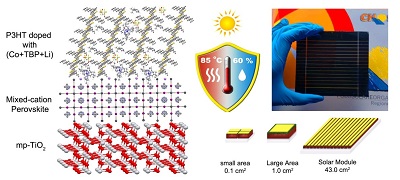
ABSTRACT
As the hole transport layer (HTL) for perovskite solar cells (PSCs), poly(3‐hexylthiophene) (P3HT) has been attracting great interest due to its low‐cost, thermal stability, oxygen impermeability, and strong hydrophobicity. In this work, a new doping strategy is developed for P3HT as the HTL in triple‐cation/double‐halide ((FA1−x−yMAxCsy)Pb(I1−xBrx)3) mesoscopic PSCs. Photovoltaic performance and stability of solar cells show remarkable enhancement using a composition of three dopants Li‐TFSI, TBP, and Co(III)‐TFSI reaching power conversion efficiencies of 19.25% on 0.1 cm2 active area, 16.29% on 1 cm2 active area, and 13.3% on a 43 cm2 active area module without using any additional absorber layer or any interlayer at the PSK/P3HT interface. The results illustrate the positive effect of a cobalt dopant on the band structure of perovskite/P3HT interfaces leading to improved hole extraction and a decrease of trap‐assisted recombination. Non‐encapsulated large area devices show promising air stability through keeping more than 80% of initial efficiency after 1500 h in atmospheric conditions (relative humidity ≈ 60%, r.t.), whereas encapsulated devices show more than >500 h at 85 °C thermal stability (>80%) and 100 h stability against continuous light soaking (>90%). The boosted efficiency and the improved stability make P3HT a good candidate for low‐cost large‐scale PSCs.
Authors:
Narges Yaghoobi Nia, Enrico Lamanna, Mahmoud Zendehdel, Alessandro L. Palma, Francesca Zurlo, Luigi Angelo Castriotta, Aldo Di Carlo
https://doi.org/10.1002/smll.201904399
"Nano-Micro Small", Volume15, Issue 49, December 6, 2019, 1904399
(first publication: 08 October 2019)
THE MOLECULAR WEIGHT DEPENDENCE OF THERMOELECTRIC PROPERTIES OF POLY (3-HEXYLTHIOPHENE)
![]()
ABSTRACT
Organic materials have been found to be promising candidates for low-temperature thermoelectric applications. In particular, poly (3-hexylthiophene) (P3HT) has been attracting great interest due to its desirable intrinsic properties, such as excellent solution processability, chemical and thermal stability, and high field-effect mobility. However, its poor electrical conductivity has limited its application as a thermoelectric material. It is therefore important to improve the electrical conductivity of P3HT layers. In this work, we studied how molecular weight (MW) influences the thermoelectric properties of P3HT films. The films were doped with lithium bis(trifluoromethane sulfonyl) imide salt (LiTFSI) and 4-tert butylpyridine (TBP). Various P3HT layers with different MWs ranging from 21 to 94 kDa were investigated. UV–Vis spectroscopy and atomic force microscopy (AFM) analysis were performed to investigate the morphology and structure features of thin films with different MWs. The electrical conductivity initially increased when the MW increased and then decreased at the highest MW, whereas the Seebeck coefficient had a trend of reducing as the MW grew. The maximum thermoelectric power factor (1.87 μW/mK2) was obtained for MW of 77 kDa at 333 K. At this temperature, the electrical conductivity and Seebeck coefficient of this MW were 65.5 S/m and 169 μV/K, respectively.
Authors:
Saeed Mardi, Marialilia Pea, Andrea Notargiacomo, Narges Yaghoobi Nia, Aldo Di Carlo, Andrea Reale
https://doi.org/10.3390/ma13061404
MDPI Journals - Materials, 13(6), 1404, 19/03/2020
MECHANICALLY STACKED, TWO-TERMINAL GRAPHENE-BASED PEROVSKITE/SILICON TANDEM SOLAR CELL WITH EFFICIENCY OVER 26%
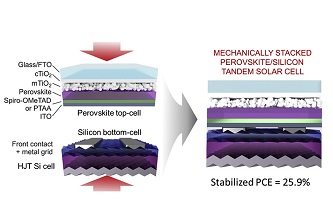
SUMMARY
Perovskite/silicon tandem solar cells represent an attractive pathway to upgrade the market-leading crystalline silicon technology beyond its theoretical limit. Two-terminal architectures result in reduced plant costs compared to four-terminal ones. However, it is challenging to monolithically process perovskite solar cells directly onto the micrometer-sized texturing on the front surface of record-high efficiency amorphous/crystalline silicon heterojunction cells, which limits both high-temperature and solution processing of the top cells. To tackle these hurdles, we present a mechanically stacked two-terminal perovskite/silicon tandem solar cell, with the sub-cells independently fabricated, optimized, and subsequently coupled by contacting the back electrode of the mesoscopic perovskite top cell with the texturized and metalized front contact of the silicon bottom cell. By minimizing optical losses, as achieved by engineering the hole selective layer/rear contact structure, and using a graphene-doped mesoporous electron selective layer for the perovskite top cell, the champion tandem device demonstrates a 26.3% efficiency (25.9% stabilized) over an active area of 1.43 cm2.
Authors:
Enrico Lamanna, Fabio Matteocci, Emanuele Calabrò, Luca Serenelli, Enrico Salza, Luca Martini, Francesca Menchini, Massimo Izzi, Antonio Agresti, Sara Pescetelli, Sebastiano Bellani, Antonio Esaú Del Río Castillo, Francesco Bonaccorso, Mario Tucci, Aldo Di Carlo
https://doi.org/10.1016/j.joule.2020.01.015
International Magazine "Joule", 17 February 2020
https://www.sciencedirect.com/science/article/abs/pii/S2542435120300453?via%3Dihub
CONSENSUS STATEMENT FOR THE DEFINITION OF THE PROCEDURES TO BE APPLIED TO ASSESSING AND MEASURING THE PEROVSKITE PHOTOVOLTAICS' STABILITY

ABSTRACT
Improving the long-term stability of perovskite solar cells is critical to the deployment of this technology. Despite the great emphasis laid on stability-related investigations, publications lack consistency in experimental procedures and parameters reported. It is therefore challenging to reproduce and compare results and thereby develop a deep understanding of degradation mechanisms. Here, we report a consensus between researchers in the field on procedures for testing perovskite solar cell stability, which are based on the International Summit on Organic Photovoltaic Stability (ISOS) protocols. We propose additional procedures to account for properties specific to PSCs such as ion redistribution under electric fields, reversible degradation and to distinguish ambient-induced degradation from other stress factors. These protocols are not intended as a replacement of the existing qualification standards, but rather they aim to unify the stability assessment and to understand failure modes. Finally, we identify key procedural information which we suggest reporting in publications to improve reproducibility and enable large data set analysis.
Authors:
Mark V. Khenkin, Eugene A. Katz, Antonio Abate, Giorgio Bardizza, Joseph J. Berry, Christoph Brabec, Francesca Brunetti, Vladimir Bulović, Quinn Burlingame, Aldo Di Carlo, Rongrong Cheacharoen, Yi-Bing Cheng, Alexander Colsmann, Stephane Cros, Konrad Domanski, Michał Dusza, Christopher J. Fell, Stephen R. Forrest, Yulia Galagan, Diego Di Girolamo, Michael Grätzel, Anders Hagfeldt, Elizabeth von Hauff, Harald Hoppe, Jeff Kettle, Hans Köbler, Marina S. Leite, Shengzhong (Frank) Liu, Yueh-Lin Loo, Joseph M. Luther, Chang-Qi Ma, Morten Madsen, Matthieu Manceau, Muriel Matheron, Michael McGehee, Rico Meitzner, Mohammad Khaja Nazeeruddin, Ana Flavia Nogueira, Çağla Odabaşı, Anna Osherov, Nam-Gyu Park, Matthew O. Reese, Francesca De Rossi, Michael Saliba, Ulrich S. Schubert, Henry J. Snaith, Samuel D. Stranks, Wolfgang Tress, Pavel A. Troshin, Vida Turkovic, Sjoerd Veenstra, Iris Visoly-Fisher, Aron Walsh, Trystan Watson, Haibing Xie, Ramazan Yıldırım, Shaik Mohammed Zakeeruddin, Kai Zhu & Monica Lira-Cantu
https://doi.org/10.1038/s41560-019-0529-5
"Nature Energy" (VOL 5 | January 2020)
PROSPECTIVE LIFE CYCLE ASSESSMENT OF THIRD-GENERATION PHOTOVOLTAICS AT THE PRE-INDUSTRIAL SCALE: A LONG-TERM SCENARIO APPROACH
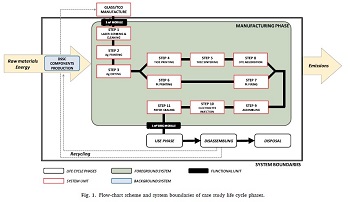

ABSTRACT
The development of sustainable technologies for energy generation should necessarily undergo sustainability assessment. A well-recognized, valuable tool to accomplish this task is the life cycle assessment. In particular, prospective life cycle assessment can provide the useful methodological framework to calculate eco-profiles of third-generation photovoltaic technologies with a future-oriented perspective. In this paper, we present the life cycle assessment of a real semi-industrial production process of dye-sensitized solar modules performed by the Italian Dyepower consortium. The results demonstrate the well-performing environmental footprint of the device and its pre-industrial fabrication process that, coupled with architectural versatility and remarkable performance in low intensity and diffuse light, make this technology suitable for different niches of the energy market. This analysis also highlights challenges in the fabrication process and identifies the technological improvements, alternative materials and engineering solutions that would further improve the environmental footprint of dye sensitized solar modules.
Maria Laura Parisi, Simone Maranghi, Luigi Vesce, Adalgisa Sinicropi, Aldo Di Carlo, Riccardo Basosi
DOI: 10.1016/j.rser.2020.109703
Renewable and Sustainable Energy Reviews 121 (2020)
TITANIUM-CARBIDE MXENES FOR WORK FUNCTION AND INTERFACE ENGINEERING IN PEROVSKITE SOLAR CELLS
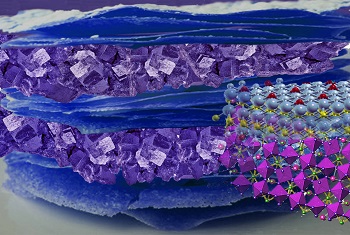
ABSTRACT
To improve the efficiency of perovskite solar cells, careful device design and tailored interface engineering are needed to enhance optoelectronic properties and the charge extraction process at the selective electrodes. Here, we use two-dimensional transition metal carbides (MXene Ti3C2Tx) with various termination groups (Tx) to tune the work function (WF) of the perovskite absorber and the TiO2 electron transport layer (ETL), and to engineer the perovskite/ETL interface. Ultraviolet photoemission spectroscopy measurements and density functional theory calculations show that the addition of Ti3C2Tx to halide perovskite and TiO2 layers permits the tuning of the materials’ WFs without affecting other electronic properties. Moreover, the dipole induced by the Ti3C2Tx at the perovskite/ETL interface can be used to change the band alignment between these layers. The combined action of WF tuning and interface engineering can lead to substantial performance improvements in MXene-modified perovskite solar cells, as shown by the 26% increase of power conversion efficiency and hysteresis reduction with respect to reference cells without MXene.
A. Agresti, A. Pazniak, S. Pescetelli, A. Di Vito, D. Rossi, A. Pecchia, M. Auf der Maur, A. Liedl, R. Larciprete, Denis V. Kuznetsov, D. Saranin, A. Di Carlo
Nature Materials, 09 September 2019
QUANTIFYING PERFORMANCE OF PERMEATION BARRIER—ENCAPSULATION SYSTEMS FOR FLEXIBLE AND GLASS‐BASED ELECTRONICS AND THEIR APPLICATION TO PEROVSKITE SOLAR CELLS
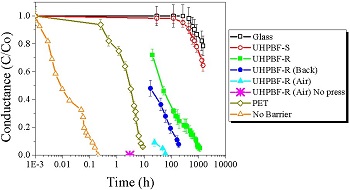
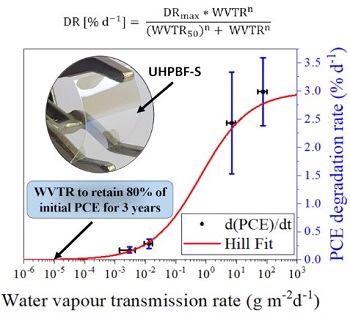
ABSTRACT
Effective transparent barrier/encapsulation systems represent a key enabling technology for large‐area electronics. Securing stability to the environment is vital. Here, the effects of architectures, application processes, and water vapor transmission rates (WVTR) of transparent flexible ultra‐high permeation barrier films (UHPBF) applied to substrates with adhesive resins are unraveled for attaining long lifetime, and compared with polyethylene terephthalate and glass barriers. How strongly performance of barrier/adhesive systems depends on barrier orientation, adhesion, manipulation, defects, and storage procedures is quantified via calcium tests. Furthermore, it is found that introducing an additional adhesion‐promoting layer on the standard UHPBF stack reduces WVTRs by a factor of 5 compared to barriers without it. Finally, barriers are used for sealing and encapsulation of perovskite solar cells (PSCs) enabling the extraction of a relationship between WVTRs of barrier/adhesive systems and degradation rates (DR) of PSCs. DR fall exponentially when WVTRs decrease from 101 to 10−3 g m−2 d−1. Outside that range any gains or losses are mitigated by tailing of the sigmoid curve relating the two parameters. Results highlight important factors which will help those developing strategies relating to encapsulation, barrier, adhesive and sealant systems and stable optoelectronic devices on glass and flexible substrates.
Sergio Castro-Hermosa, Michiel Top, Janardan Dagar, John Fahlteich, Thomas M. Brown
https://doi.org/10.1002/aelm.201800978
Advanced Electronic Materials, 14 August 2019
Altri articoli...
- FABRICATION AND MORPHOLOGICAL CHARACTERIZATION OF HIGH EFFICIENCY BLADE-COATED PEROVSKITE SOLAR MODULES
- THE EFFECT OF WATER IN CARBON-PEROVSKITE SOLAR CELLS WITH OPTIMIZED ALUMINA SPACER
- SCALING-UP OF DYE SENSITIZED SOLAR MODULES
- PRINTED SOLAR CELLS AND ENERGY STORAGE DEVICES ON PAPER SUBSTRATES
- THERMALLY INDUCED FULLERENE DOMAIN COARSENING PROCESS IN ORGANIC SOLAR CELLS




